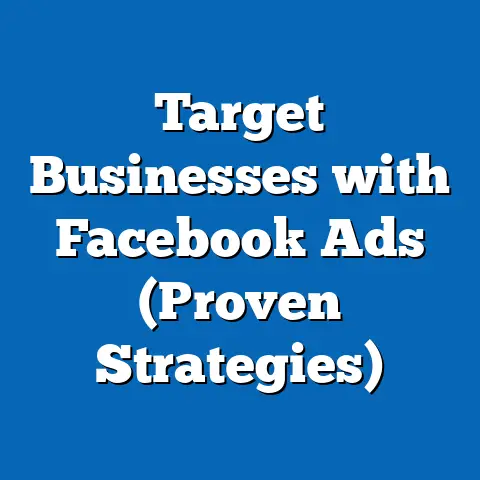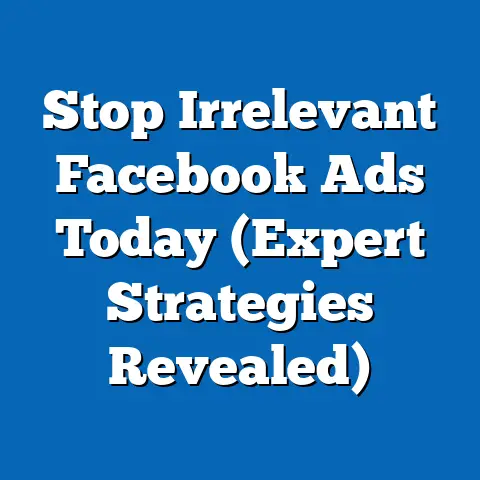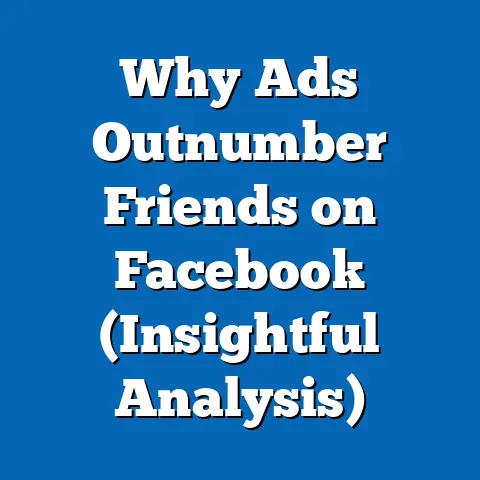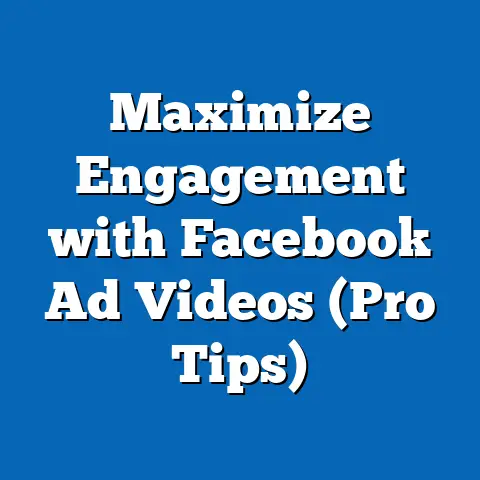Master Targeting with Facebook Ads (Expert Strategies Revealed)
What if you could reach your ideal customer with pinpoint accuracy, ensuring every dollar spent on Facebook ads translates into sales? Imagine launching a campaign that not only resonates with your target audience but also drives unparalleled engagement and conversions. This isn’t just a dream; it’s achievable with the right targeting strategies on Facebook. I’ve spent years navigating the intricacies of Facebook advertising, and I’m excited to share my insights on how you can master targeting and transform your campaigns.
1. Understanding Facebook Ads Targeting
Targeting on Facebook Ads is the process of selecting specific demographics, interests, behaviors, and locations to show your ads to the most relevant people. It’s the foundation of a successful campaign, ensuring your message reaches those most likely to engage and convert.
Why Targeting Matters
In digital marketing, targeting is crucial because it maximizes your ROI. Unlike traditional advertising, where you broadcast your message to a wide, often irrelevant audience, Facebook allows you to narrow your focus, ensuring that your ad spend is used efficiently. I’ve seen campaigns where simply refining the targeting parameters doubled conversion rates.
Layers of Targeting
Facebook offers several layers of targeting, including:
- Demographics: Age, gender, education, job title, etc.
- Interests: Hobbies, passions, and topics users have shown interest in.
- Behaviors: Purchasing habits, device usage, and other online activities.
- Location: Country, region, city, or even a specific radius around a location.
Takeaway: Understanding the different layers of targeting is the first step to creating effective Facebook ad campaigns.
2. The Facebook Audience Insights Tool
The Facebook Audience Insights tool is a powerful resource for understanding your potential customers. It provides aggregated information about people on Facebook, allowing you to identify trends, interests, and behaviors.
Accessing Audience Insights
To access Audience Insights:
- Go to Facebook Ads Manager.
- Click on “All Tools” in the left-hand menu.
- Select “Audience Insights” under the “Plan” section.
Using Audience Insights Effectively
Once you’re in the tool, you can choose to analyze everyone on Facebook or people connected to your page. I typically start by analyzing everyone on Facebook to get a broad understanding of potential audiences.
Here are some key areas to explore:
- Demographics: Understand the age, gender, relationship status, education level, and job titles of your target audience.
- Page Likes: Discover the pages your audience likes, which can reveal their interests and preferences.
- Location: See where your audience is located, which can help with geo-targeting.
- Activity: Analyze their device usage and purchasing behavior.
Interpreting the Data
For example, if you’re selling organic skincare products, you might find that your target audience is primarily women aged 25-45, interested in wellness, natural living, and organic products. They might also like pages related to yoga, healthy recipes, and environmental conservation.
Takeaway: Use Audience Insights to gather data-driven insights about your potential customers, informing your targeting decisions.
3. Custom Audiences: Retargeting and Beyond
Custom Audiences allow you to target specific groups of people based on their existing relationship with your business. This is a game-changer for retargeting and creating highly relevant ad campaigns.
What are Custom Audiences?
Custom Audiences are created from various sources, including:
- Customer Lists: Upload a list of email addresses or phone numbers.
- Website Traffic: Target people who have visited your website or specific pages.
- App Activity: Target people who have used your mobile app.
- Engagement on Facebook: Target people who have interacted with your Facebook page or ads.
Creating Custom Audiences
To create a Custom Audience:
- Go to Facebook Ads Manager.
- Click on “Audiences” in the left-hand menu.
- Click on “Create Audience” and select “Custom Audience.”
- Choose your source (e.g., website traffic, customer list).
- Follow the prompts to upload your data or configure your settings.
Lookalike Audiences
Once you have a Custom Audience, you can create a Lookalike Audience, which targets people who share similar characteristics with your existing customers. This is a fantastic way to expand your reach while maintaining relevance.
Case Study
I once worked with an e-commerce client who sold handmade jewelry. By creating a Custom Audience of website visitors who abandoned their shopping carts and then creating a Lookalike Audience based on that group, we saw a 30% increase in conversions.
Takeaway: Custom and Lookalike Audiences are powerful tools for retargeting and expanding your reach to new, highly relevant audiences.
4. Demographic Targeting: The Basics
Demographic targeting allows you to reach people based on their age, gender, education, job title, and life events.
Age and Gender
These are the most basic demographic targeting options. Consider the age and gender of your ideal customer when setting up your campaigns. For example, if you’re selling men’s grooming products, you’ll want to target men in specific age ranges.
Education and Job Title
Targeting based on education and job title can be useful for specific industries. For instance, if you’re offering a course on data science, you might target people with a background in mathematics or computer science.
Life Events
Facebook also allows you to target people based on life events such as new jobs, anniversaries, or recent moves. This can be highly effective for targeted promotions.
Takeaway: Demographic targeting is a fundamental aspect of Facebook advertising, allowing you to tailor your message to specific groups of people.
5. Interest-Based Targeting: Finding Your Niche
Interest-based targeting allows you to reach people based on their hobbies, passions, and topics they’ve shown interest in on Facebook.
Identifying Relevant Interests
The key to successful interest-based targeting is thorough research. Use the Audience Insights tool to identify the interests of your target audience. Look for patterns and common themes.
Advanced Strategies
Don’t just target broad interests. Narrow down your targeting to specific interests that are highly relevant to your product or service. For example, instead of targeting “fitness,” target “yoga,” “Pilates,” or “CrossFit.”
Takeaway: Interest-based targeting is a powerful way to reach people who are genuinely interested in what you have to offer.
6. Behavioral Targeting: Understanding Customer Actions
Behavioral targeting allows you to reach users based on their online behavior, such as purchasing habits, device usage, and travel history.
Examples of Behavioral Targeting
- Purchasing Behavior: Target people who frequently purchase online or who have purchased specific types of products.
- Device Usage: Target people based on the type of device they use (e.g., iPhone users, Android users).
- Travel History: Target people who have recently traveled to specific locations.
Ethical Considerations
It’s important to be mindful of privacy when using behavioral targeting. Avoid targeting sensitive information and always adhere to Facebook’s advertising policies.
Takeaway: Behavioral targeting can be highly effective, but it’s important to use it responsibly and ethically.
7. Geo-Targeting: Reaching Local Markets
Geo-targeting allows you to reach people based on their location, from country-level to specific radius targeting around a business.
Geo-Targeting Options
- Country: Target people in specific countries.
- Region: Target people in specific regions or states.
- City: Target people in specific cities.
- Radius Targeting: Target people within a specific radius around a location (e.g., 10 miles around a store).
Examples of Effective Geo-Targeting
If you own a local restaurant, you can use geo-targeting to reach people within a 5-mile radius of your restaurant. You can also target people who are visiting your city to promote your business to tourists.
Takeaway: Geo-targeting is essential for businesses that want to reach local customers or target specific geographic areas.
8. Ad Placements and Formats: Optimizing for Engagement
The placement and format of your ads can significantly impact their effectiveness.
Ad Placements
Facebook offers various ad placements, including:
- Facebook Feed: Ads appear in the news feed.
- Instagram Feed: Ads appear in the Instagram feed.
- Facebook Stories: Ads appear between users’ stories.
- Instagram Stories: Ads appear between users’ stories.
- Facebook Marketplace: Ads appear in the Marketplace.
- Audience Network: Ads appear on websites and apps outside of Facebook.
Ad Formats
Facebook offers various ad formats, including:
- Single Image Ads: Ads with a single image.
- Video Ads: Ads with a video.
- Carousel Ads: Ads with multiple images or videos that users can scroll through.
- Slideshow Ads: Ads that combine multiple images into a slideshow.
A/B Testing
Experiment with different placements and formats to see what works best for your target audience. I’ve found that video ads often perform well in the Facebook feed, while image ads can be effective in Instagram Stories.
Takeaway: Optimize your ad placements and formats to maximize engagement and reach your target audience effectively.
9. The Importance of A/B Testing in Targeting
A/B testing is the process of comparing two versions of an ad campaign to see which one performs better. This is crucial for refining your targeting strategies.
Setting Up A/B Tests
To set up an A/B test for audience targeting:
- Go to Facebook Ads Manager.
- Create a new campaign.
- Set up two ad sets with different targeting parameters.
- Use the same ad creative in both ad sets.
- Run the campaign for a specific period and analyze the results.
Analyzing Results
Monitor key performance indicators (KPIs) such as:
- Reach: The number of people who saw your ad.
- Impressions: The number of times your ad was displayed.
- Click-Through Rate (CTR): The percentage of people who clicked on your ad.
- Conversion Rate: The percentage of people who completed a desired action (e.g., purchase, sign-up).
- Cost Per Conversion: The cost of acquiring a conversion.
Takeaway: A/B testing is essential for optimizing your targeting strategies and improving your ad performance.
10. Ad Copy and Creative: Speaking to Your Audience
Your ad copy and creative should be tailored to your target audience.
Crafting Compelling Ad Copy
Use language that resonates with your target audience. Highlight the benefits of your product or service and address their specific needs and pain points.
Examples of Successful Ad Creatives
- Visuals: Use high-quality images or videos that capture attention and convey your message effectively.
- Text: Keep your ad copy concise and easy to understand. Use a clear call to action.
- Relevance: Make sure your ad copy and creative are relevant to your target audience.
Takeaway: Your ad copy and creative should be tailored to your target audience to maximize engagement and conversions.
11. Analyzing and Optimizing Targeting Efforts
Tracking the success of your targeting efforts is essential for ongoing optimization.
Key Performance Indicators (KPIs)
Monitor the following KPIs in Facebook Ads Manager:
- Reach: The number of people who saw your ad.
- Impressions: The number of times your ad was displayed.
- Click-Through Rate (CTR): The percentage of people who clicked on your ad.
- Conversion Rate: The percentage of people who completed a desired action.
- Cost Per Conversion: The cost of acquiring a conversion.
Ongoing Optimization
Based on your performance data, make adjustments to your targeting parameters. Refine your audience segments, test different ad placements and formats, and update your ad copy and creative.
Takeaway: Continuously analyze and optimize your targeting efforts to improve your ad performance and achieve your business goals.
12. Future Trends in Facebook Ads Targeting
The landscape of Facebook ads targeting is constantly evolving.
Privacy Regulations
Privacy regulations such as GDPR and CCPA are impacting data tracking and audience targeting. Advertisers need to be mindful of these regulations and adapt their strategies accordingly.
Technological Advancements
Technological advancements such as artificial intelligence (AI) and machine learning (ML) are enabling more sophisticated targeting options. Advertisers can leverage these technologies to create highly personalized and relevant ad experiences.
Preparing for Changes
Stay informed about the latest trends and changes in Facebook ads targeting. Be prepared to adapt your strategies as needed to remain effective.
Takeaway: Stay informed about future trends in Facebook ads targeting to remain competitive and effective in the evolving landscape of social media advertising.
Conclusion
Mastering Facebook ads targeting is essential for success in digital marketing. By understanding the different layers of targeting, using the Audience Insights tool, creating Custom and Lookalike Audiences, and continuously analyzing and optimizing your efforts, you can create highly effective ad campaigns that reach your ideal customers and drive results. Take action today and apply these expert strategies to enhance your ad campaigns and achieve your business goals.






